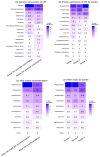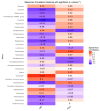Gut Microbiota: Association with Fiber Intake, Ultra-Processed Food Consumption, Sex, Body Mass Index, and Socioeconomic Status in Medical Students
- PMID: 39683634
- PMCID: PMC11644225
- DOI: 10.3390/nu16234241
Gut Microbiota: Association with Fiber Intake, Ultra-Processed Food Consumption, Sex, Body Mass Index, and Socioeconomic Status in Medical Students
Abstract
The gut microbiota plays a vital role in various physical and physiological processes, including immune system regulation, neurotransmitter production, inflammatory response modulation, and the inhibition of pathogenic organisms. An imbalance in the microbial community, known as dysbiosis, has been associated with numerous health issues. Biological influences, health behaviors, socioeconomic determinants, and nutritional status can disrupt this balance.
Objective: To evaluate the differences in the gut microbiota composition in medical students according to fiber intake, ultra-processed food (UPF) consumption, sex, body mass index, and socioeconomic status.
Methods: A cross-sectional study was conducted with 91 medical students, and 82 fecal samples were analyzed. Sociodemographic and dietary data were collected via questionnaires, UPF consumption was assessed using the NOVA classification, and trained nutritionists performed anthropometry. DNA extraction and 16S rRNA sequencing were performed for the microbial analysis. Bioinformatics and statistical tests included the Dunn and Kruskal-Wallis tests, a PCoA analysis, PERMANOVA, ANOVA, Spearman's rank correlation, and alpha and beta diversity metrics.
Results: Dietary fiber intake strongly influences gut microbiota composition. Lower fiber intake was associated with a higher prevalence of Parabacteroides and Muribaculaceae. Prevotella was more prevalent in individuals with lower UPF intake, while Phascolarctobacterium was prevalent in those with higher UPF consumption. Significant differences were associated with sex and UPF consumption but not BMI or SES. Women consumed more UPF, which correlated with distinct gut microbiota profiles.
Conclusions: This study highlights the significant impact of diet, particularly fiber intake and UPF, on gut microbiota composition, emphasizing the importance of dietary habits in maintaining gut health.
Keywords: diet; fiber intake; gut microbiota; medical student; obesity; overweight; socioeconomic status; ultra-processed food.
Conflict of interest statement
The authors declare no conflicts of interest.
Figures





Similar articles
-
The link between ultra-processed food consumption, fecal microbiota, and metabolomic profiles in older mediterranean adults at high cardiovascular risk.Nutr J. 2025 Apr 17;24(1):62. doi: 10.1186/s12937-025-01125-5. Nutr J. 2025. PMID: 40247349 Free PMC article.
-
Effect of ultra-processed food consumption on the gut microbiota in the first year of life: Findings from the MINA-Brazil birth cohort study.Clin Nutr. 2025 Mar;46:181-190. doi: 10.1016/j.clnu.2025.01.030. Epub 2025 Feb 6. Clin Nutr. 2025. PMID: 39954456
-
Differences in the gut microbiota of women according to ultra-processed food consumption.Nutr Metab Cardiovasc Dis. 2023 Jan;33(1):84-89. doi: 10.1016/j.numecd.2022.09.025. Epub 2022 Oct 11. Nutr Metab Cardiovasc Dis. 2023. PMID: 36411218
-
A Systematic Review of Worldwide Consumption of Ultra-Processed Foods: Findings and Criticisms.Nutrients. 2021 Aug 13;13(8):2778. doi: 10.3390/nu13082778. Nutrients. 2021. PMID: 34444936 Free PMC article.
-
Ultra-Processed Foods: A Narrative Review of the Impact on the Human Gut Microbiome and Variations in Classification Methods.Nutrients. 2024 Jun 1;16(11):1738. doi: 10.3390/nu16111738. Nutrients. 2024. PMID: 38892671 Free PMC article. Review.
Cited by
-
The Bacterial Composition of the Gut Microbiota of Mexicans with Overweight and Obesity: A Systematic Review.Microorganisms. 2025 Jul 24;13(8):1727. doi: 10.3390/microorganisms13081727. Microorganisms. 2025. PMID: 40871231 Free PMC article. Review.
-
The mediating role of body mass index in the association between unprocessed or minimally processed foods and gallstones.Front Nutr. 2025 Jun 23;12:1589805. doi: 10.3389/fnut.2025.1589805. eCollection 2025. Front Nutr. 2025. PMID: 40626232 Free PMC article.
-
Association of the Dietary Index for Gut Microbiota and Cardiovascular-Kidney-Metabolic Syndrome: The Mediation Effect of Phenotypic and Biological Age Acceleration, BMI, and BRI.Food Sci Nutr. 2025 Sep 7;13(9):e70815. doi: 10.1002/fsn3.70815. eCollection 2025 Sep. Food Sci Nutr. 2025. PMID: 40927048 Free PMC article.
References
-
- Nobre J.G., Alpuim Costa D. “Sociobiome”: How do socioeconomic factors influence gut microbiota and enhance pathology susceptibility?—A mini-review. Front. Gastroenterol. 2022;1:1020190. doi: 10.3389/fgstr.2022.1020190. - DOI
MeSH terms
Substances
Grants and funding
LinkOut - more resources
Full Text Sources
Medical

